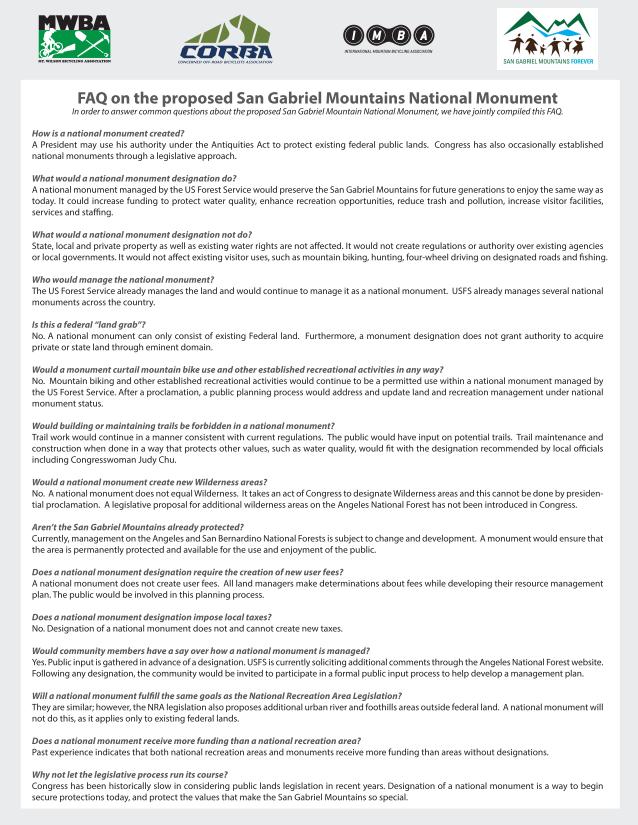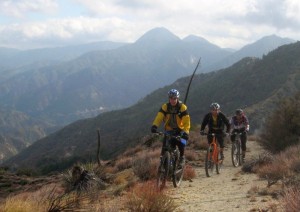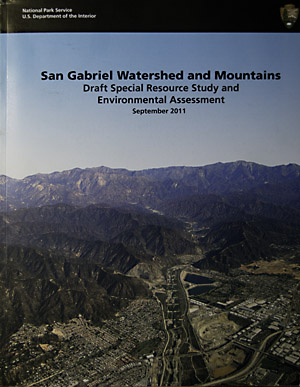As previously reported, CORBA has been working with several other groups to get assurances that our needs will be met when and if the San Gabriels are declared a National Monument. As we’ve received answers to many of those questions, the answers have been compiled into a set of frequently asked questions, or “FAQ’s” about the National Monument.
We’ve also seen correspondence from members of congress that support our position for continued bicycle access, along with all other forms of recreation currently allowed in the Angeles National Forest. We’re confident that under a National Monument, we’ll be able to continue riding the trails and volunteering to maintain them as we do now. This is a vision for the San Gabriel Mountains that we can support.
That said, we must say that our support is tentative, and conditional on the final language of the proclamation and its accompanying preamble reflecting these recreational goals and ideals. We have not yet seen that final language, nor received any direct confirmation of the contents of the proclamation. While verbal assurances are helpful, until it is finalized and in writing, we feel it’s too early to proclaim our outright support. We have co-authored a letter that outlines a vision of a National Monument that we can and will support. We’re hopeful that letter has been given due consideration.
Today the Los Angeles Times published an opinion piece that closely reflects our position. They support the designation, but do so with skepticism of the proponents’ claims that this will make all the trash, graffiti, and lack of maintenance go away. The only thing that will make these things go away is funding for the additional staff, rangers, education, law enforcement, and maintenance crews needed to manage the forest. While a National Monument greatly increases the opportunities for more funding and staff, it comes with no outright guarantee.
 News has just been released that President Obama may declare the National Monument as soon as this Friday, two days from now. For us and many others, this is a far too hasty response. If the proclamation is as we have been led to expect–acknowledging the value and importance of continued recreational access including bicycles–then we should have no problem. But we fail to see the need to push this through less than two months after the public learned of this proposal, and six weeks after the one and only “public meeting” (in which the public were not able to speak). At that meeting, even members of the invited panel of speakers raised questions that as yet, remain unanswered.
News has just been released that President Obama may declare the National Monument as soon as this Friday, two days from now. For us and many others, this is a far too hasty response. If the proclamation is as we have been led to expect–acknowledging the value and importance of continued recreational access including bicycles–then we should have no problem. But we fail to see the need to push this through less than two months after the public learned of this proposal, and six weeks after the one and only “public meeting” (in which the public were not able to speak). At that meeting, even members of the invited panel of speakers raised questions that as yet, remain unanswered.
Both San Bernardino and Los Angeles Counties have come out against the Monument proposal, in part because of a lack of public outreach and answers as to how this will really impact their constituents.
We’d have prefered a slower approach with more public participation. There are many individuals and organizations adamantly opposed to the Monument. If allowed to voice their concerns and have them addressed and answered, some of that opposition would be reduced. As it is, this rushed process is just fueling their anger and outrage at a lack of public outreach. However, we remain hopeful and confident that any impending announcement will be favorable to mountain bikes.
The following FAQ’s are a summary of the questions and answers we’ve compiled in collaboration with IMBA, Mount Wilson Bicycling Association, San Gabriel Mountains Forever, The Wilderness Society, and the Conservation Land Trust.
With these questions answered, and the assurances from multiple sources (in lieu of the final proclamation language) of our continued access, we are giving our conditional support to the proposal.





